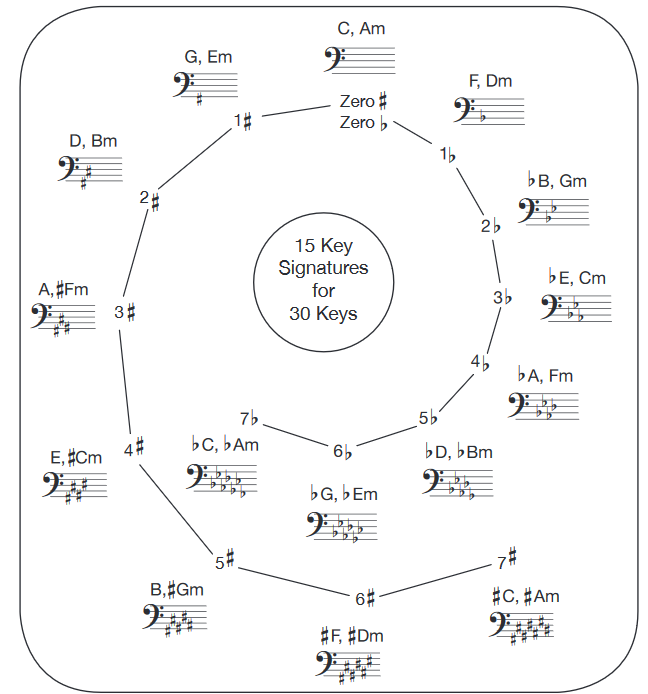The Nature of the Sign
By the Early 18th Century, the 12 Tone equal temperament tuning system, with its 15 key signatures and 30 keys, began to take root.
Enharmonic is one sound with two different symbolic letter names. For example, sharp F (♯F) and flat G (♭G) sound the same, but they have
different letter names. Key signatures evolved as a way of identifying these enharmonic pitches. But here’s the amazing thing, the enharmonic
sound could only be given the correct letter name after you knew what key you were in. Here’s an example, in the key of D major the sound is called ♯F,
but in the key of ♭D, the same sound is called ♭G. And if that isn’t confusing enough, because of enharmonic, there are only 12 major keys by sound,
but today, there are 15 major key signatures by symbolic letter name.
In 1722, J.S. Bach wrote the Well Tempered Clavier to exploit this new-found ability to play sound in 12 keys.
A clavier is a keyboard. It’s interesting to note that the board of this musical instrument was used to work out the 12 keys. Get it, the board of keys, aka, the keyboard!
Bach’s system of ordering the key signatures was to present a major key and then its parallel minor key.
Parallel means that the first sound of the major key and its parallel minor key have the same letter. Therefore, the first Prelude and Fugue is written in the key of
C major and then followed by its parallel minor key, C minor . Now, here’s the important point, parallel major and minor keys have two different key signatures.
Bach also presents the key signatures chromatically. Chromatic means by half-step, which is the distance of one fret on the bass.
The following is Bach’s major key signature order coupled with their parallel minor keys: C major, C minor; ♯C major, ♯C minor, D major, D minor;
♭E major, ♯D minor; E major, E minor; F major, F minor; ♯F major, ♯F minor; G major, G minor; ♭A major, ♯G minor; A major, A minor; ♭B major,
♭B minor; B major and B minor.
Notice that Bach does not use the key signature or key of ♭C major, ♭C minor; ♭D major, ♭D minor; ♭G major, ♭G minor; or ♭A minor.
But curiously, he uses both ♯D minor and ♭E minor. This presents a case for his understanding and use of equal temperament. It’s also interesting to note that Bach
uses the key signature of 7 sharp letters, ♯C, rather than the simpler key signature of 5 flat letters, ♭D. The reason is easier to understand when we realize that
it saves time.
Think of it this way. If you write a song in the key signature of C major and then want to play it in ♯C major, all you have to do is place the ♯C key
signature on the staff and you’re done. However, if you wanted to play it in ♭D major, which would sound exactly the same, you would have to add the 5 flats to the staff,
and then rewrite every note on the staff! That’s a lot more work.
Bach’s ordering of 12 key signatures differs from the way key signatures are presented today.
In the 21st Century, 15 key signatures are shown in a purely numeric order, from zero sharps and zero flats, through seven sharps and seven flats.
Here’s something significant, the major keys are coupled with their relative minor keys.
Relative means that the major key and its relative minor key contain the same letters, but in a different order.
For this reason, major and relative minor keys share the same key signature.
A sign indicates an action, and nature is the character of something. Therefore, sign + nature = signature, or, the nature of the sign.
Here’s a simple example, your autograph is your signature which indicates your character.
In the Tone Note® Music Method, key is not an abbreviation of key signature, key is simply the letter of tone 1.
When you know the key, you know one letter and one scaled-degree number, tone 1.
In traditional music notation, the signature is added to reveal six more letters and tone numbers: 2 through 7.
Now, when you holistically connect the key, the letter of tone 1, with the signature, the six letters of tones 2 through 7, the result is the 7 letters
and 7 tone numbers of the key signature!
At this point, traditional music then symbolizes the key signature as a certain number of sharps or flats, and then places them on the staff at the
beginning of the song between the clef and the time signature. And yet, after all that, you know what the key signature is, but you still don’t know what the key is!
This is because even though there is only one key signature, probability theory says there are two possible keys.
In other words, although you know the key signature, the only way to know with absolute certainty what key you’re in, is to analyze the song. But that’s another lesson.
So, let’s end this lesson by showing a parabola of 15 key signatures coupled with their 30 major and relative minors keys.

‘Til next time, have some signature fun, no matter what key you’re in... I’ll be listening.
Return to Accomplished Lessons